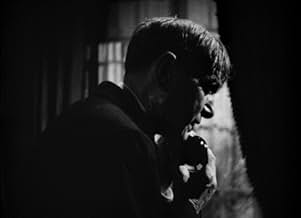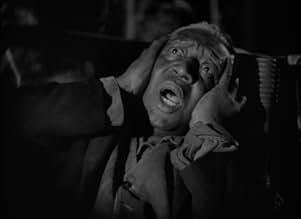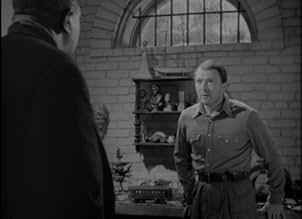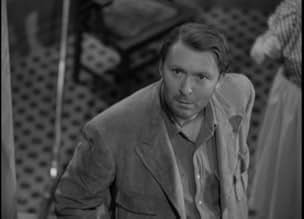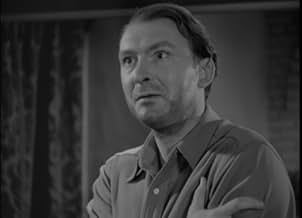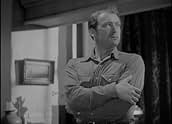Ajouter une intrigue dans votre langueA mentally unstable man who has been kept in isolation for years escapes and causes trouble for his identical twin brother.A mentally unstable man who has been kept in isolation for years escapes and causes trouble for his identical twin brother.A mentally unstable man who has been kept in isolation for years escapes and causes trouble for his identical twin brother.
- Réalisation
- Scénario
- Casting principal
Jane Allen
- Jitterbug Dancer
- (non crédité)
Rod Cameron
- Eddie - Man in Cafe
- (non crédité)
Eddy Chandler
- Motorcycle Cop
- (non crédité)
Lane Chandler
- Neighbor
- (non crédité)
Catherine Craig
- Second Mill Girl
- (non crédité)
Avis à la une
The plot to "Among the Living" is silly and impossible to believe. However, it does appear to be the inspiration for an episode of "The Simpsons"--the one where Bart discovers that he has an identical 'evil' twin who's been locked in the attic for many years! Homer and Marge feed Hugo fish heads and have kept his existence a secret for years! Who would have thought a film would have dared have such a bizarro plot?!
When the film begins, the family patriarch dies and his son John (Albert Dekker) arrives for the funeral. Little does John know that his identical brother, Paul (also Dekker), is STILL alive and did not die as a small child. The family doctor (Harry Carey) divulges the family secret to John...Paul is still alive and insane and has been kept hidden in a secret room in the family mansion! Coincidentally, at this same time, Paul kills his keeper and escapes! Now two identical looking guys are running about town...and one is on occasion unpredictable and homicidal. So it's up to the Doctor and John to try to find Paul...however the heartless Doctor soon tries to stop John from contacting the police by threatening to destroy him! However, Paul is not intend with only killing his keeper...and the bodies start piling up in town. And, soon John is assumed to be the crazed killer by mistake!
As I mentioned above, the plot for this one is just insane...so you really have to suspend disbelief in order to watch this one. Despite this, I did enjoy Dekker's performance as he played both characters, particularly Paul, quite well. Goofy and still very watchable.
When the film begins, the family patriarch dies and his son John (Albert Dekker) arrives for the funeral. Little does John know that his identical brother, Paul (also Dekker), is STILL alive and did not die as a small child. The family doctor (Harry Carey) divulges the family secret to John...Paul is still alive and insane and has been kept hidden in a secret room in the family mansion! Coincidentally, at this same time, Paul kills his keeper and escapes! Now two identical looking guys are running about town...and one is on occasion unpredictable and homicidal. So it's up to the Doctor and John to try to find Paul...however the heartless Doctor soon tries to stop John from contacting the police by threatening to destroy him! However, Paul is not intend with only killing his keeper...and the bodies start piling up in town. And, soon John is assumed to be the crazed killer by mistake!
As I mentioned above, the plot for this one is just insane...so you really have to suspend disbelief in order to watch this one. Despite this, I did enjoy Dekker's performance as he played both characters, particularly Paul, quite well. Goofy and still very watchable.
... 1941 that is. It boasts fine photography and a great score. It's part horror tale, part noir. John Raden returns for the funeral of Maxim Raden, his father and owner of all of the mills around town. It's obvious from the remarks of the average citizens outside the cemetery gates that their collective sentiment is good riddance.
Dr. Ben Saunders (Harry Carey) then reveals to John a terrible secret he's been keeping - that 25 years ago he forged a death certificate for John's identical twin brother Paul. Paul had become mentally disturbed and Maxim moved into a hotel in town and kept the insane Paul locked up in a room at Radin mansion with kindly and loyal servant Pompey as his keeper. Paul became disturbed probably due to a head injury received when his father threw him across the room when Paul came to his mother's rescue during one of the beatings Maxim was giving her. What did Dr. Saunders get in return? Maxim Radin endowed his clinic, but with Paul recently turning more violent, both Saunders' psychological and actual burden have become heavier and heavier. John, sent away to school before any of this happened, had no knowledge of any of this up until now.
Well, Paul kills Pompey, escapes his room, and finds some money at his father's grave. (It was unclear to me what money was doing there.) With this money and his misleading mostly gentle child-like demeanor he manages to rent a room in a rooming house and attract the attentions of the landlady's daughter (Susan Hayward as Millie Pickens). Millie teaches Paul to blend in - helps him find new clothes, gets him to shave - and now the town has an unpredictable homicidal maniac in its midst who only acts homicidal when the urge to kill strikes him but doesn't look the least bit out of place. Meanwhile, John Raden cannot convince Saunders to call the police because he doesn't want to lose the clinic he's worked so hard for. Of course the fact that the townspeople think Paul is dead and Paul and John are identical twins will eventually figure into this plot, but I'll let you watch and see how.
Albert Dekker does a great job of playing the dual role of sophisticated good guy John and child-like insane Paul, but it is Susan Hayward as Millie who steals the show. You can never quite tell if she really likes Paul because he's different - not pawing her all of the time - or if she's just after the gifts he can give her after she sees the wad of cash he keeps in his pockets. It's a great early role for her. Harry Carey gets to do more than he usually does late in his career, which were roles that usually entailed playing the wise old good guy. Here he is quite gray and not until the end are you sure just which side of his character will win. For those of you looking for a glimpse of Frances Farmer at work, that's all you'll get - a glimpse. She is barely noticeable as the wife of John Raden.
As for the atmosphere - it's perfect with thunderstorms, poorly lit rooms, cemeteries at night, and Paul's victims all found left with a terrified expression and their hands over their ears. Highly recommended for fans of old style horror. It's a shame this one isn't better known.
Dr. Ben Saunders (Harry Carey) then reveals to John a terrible secret he's been keeping - that 25 years ago he forged a death certificate for John's identical twin brother Paul. Paul had become mentally disturbed and Maxim moved into a hotel in town and kept the insane Paul locked up in a room at Radin mansion with kindly and loyal servant Pompey as his keeper. Paul became disturbed probably due to a head injury received when his father threw him across the room when Paul came to his mother's rescue during one of the beatings Maxim was giving her. What did Dr. Saunders get in return? Maxim Radin endowed his clinic, but with Paul recently turning more violent, both Saunders' psychological and actual burden have become heavier and heavier. John, sent away to school before any of this happened, had no knowledge of any of this up until now.
Well, Paul kills Pompey, escapes his room, and finds some money at his father's grave. (It was unclear to me what money was doing there.) With this money and his misleading mostly gentle child-like demeanor he manages to rent a room in a rooming house and attract the attentions of the landlady's daughter (Susan Hayward as Millie Pickens). Millie teaches Paul to blend in - helps him find new clothes, gets him to shave - and now the town has an unpredictable homicidal maniac in its midst who only acts homicidal when the urge to kill strikes him but doesn't look the least bit out of place. Meanwhile, John Raden cannot convince Saunders to call the police because he doesn't want to lose the clinic he's worked so hard for. Of course the fact that the townspeople think Paul is dead and Paul and John are identical twins will eventually figure into this plot, but I'll let you watch and see how.
Albert Dekker does a great job of playing the dual role of sophisticated good guy John and child-like insane Paul, but it is Susan Hayward as Millie who steals the show. You can never quite tell if she really likes Paul because he's different - not pawing her all of the time - or if she's just after the gifts he can give her after she sees the wad of cash he keeps in his pockets. It's a great early role for her. Harry Carey gets to do more than he usually does late in his career, which were roles that usually entailed playing the wise old good guy. Here he is quite gray and not until the end are you sure just which side of his character will win. For those of you looking for a glimpse of Frances Farmer at work, that's all you'll get - a glimpse. She is barely noticeable as the wife of John Raden.
As for the atmosphere - it's perfect with thunderstorms, poorly lit rooms, cemeteries at night, and Paul's victims all found left with a terrified expression and their hands over their ears. Highly recommended for fans of old style horror. It's a shame this one isn't better known.
Sharp, tightly paced low budget film is hard to categorize. There are definitely noirish tendencies but it's not a full blown film noir, there are also elements of horror contained within but neither is a horror movie. Even as a hybrid of different genres it is very involving and uses it short running time to full effect, actually so effective that it received quite a lot of critical attention in its day for a lower budget release and helped move its leading lady's career forward.
Speaking of the leading lady the film is also a study of two stars in flight. Susan Hayward whose full fledged stardom was still a few years away was still definitely on her way up, Frances Farmer, whose part is small, was most definitely on the descent. At one time considered an actress with the brightest of futures this was her second to last picture before descending into a decades long hell of mental illness and involuntary confinement.
The real standout though is Albert Dekker in a dual role of very different twin brothers. An excellent character actor who met a grisly end he rarely had the opportunity of the leading role but he takes his chance here and makes the most of it. His body language and vocal inflections makes the two characters recognizably different men and their struggles relatable. Not readily available and hard to find its definitely worth the effort to seek out.
Speaking of the leading lady the film is also a study of two stars in flight. Susan Hayward whose full fledged stardom was still a few years away was still definitely on her way up, Frances Farmer, whose part is small, was most definitely on the descent. At one time considered an actress with the brightest of futures this was her second to last picture before descending into a decades long hell of mental illness and involuntary confinement.
The real standout though is Albert Dekker in a dual role of very different twin brothers. An excellent character actor who met a grisly end he rarely had the opportunity of the leading role but he takes his chance here and makes the most of it. His body language and vocal inflections makes the two characters recognizably different men and their struggles relatable. Not readily available and hard to find its definitely worth the effort to seek out.
I’d always been interested in this one – not least because it involves twins (and, thus, reminiscent of the Boris Karloff vehicle THE BLACK ROOM [1935]) – so that when I came across the film, even if I knew that the quality would be far from optimal, I leapt at the chance to acquire it. While not strictly horror, it involves several elements that are part and parcel of the genre – old dark house, family secret, madness, murder, mob fury, etc.
Despite, as I said, the fact that the video was rather fuzzy – so that the images generally lacked detail – I was nonetheless struck by the film’s cinematography and editing: these were particularly effective during a scene at a bar, where the mad brother (who had been secluded all his life but has now broken loose) is ridiculed by the customers, and the one following it where he chases a girl into an alley and kills her. The two central roles are played by Albert Dekker and he does very well by both, though the mad brother is obviously the showier character – which he invests with a remarkable vulnerability (when seeing the locals indulging in a particularly animated jitterbug routine, he naively asks his future victim who’s accompanying him at the time “What are they doing?”); incidentally, despite the narrative’s Gothic – or, more precisely, Southern – trappings, the setting is a contemporary one.
The supporting cast is a good one and includes: a young Susan Hayward (that is, before she became, the First Lady of Screen Melodrama) as the perky small-town girl who entrances the crazy Dekker – which she’s all-too-willing to play up to, but who promptly and fiercely turns against him when he’s eventually revealed to be the cause of the terror which has gripped the community!; Harry Carey in the ambivalent role of the town doctor who, having been complicit in the cover-up of the mad brother’s existence, fears the repercussions of this act if he were to intervene when – at the satisfactorily frenzied climax – the good Dekker is accused of his brother’s crimes!; and the troubled Frances Farmer who, however, is wasted in the colorless role of the innocent sibling’s wife (in a virtual prerequisite of genre heroines, the actress is also asked to scream – which she does unconvincingly! – in her one scene with the mad Dekker).
The film is a Paramount production and, therefore, currently owned by Universal; while the latter have served their horror back-catalogue reasonably well on DVD, the equivalent stuff from that other studio has been consistently (and bafflingly) neglected over the years – especially since this includes such highly-desirable titles as ISLAND OF LOST SOULS (1932), MURDERS IN THE ZOO (1933) and, now, AMONG THE LIVING itself...
Despite, as I said, the fact that the video was rather fuzzy – so that the images generally lacked detail – I was nonetheless struck by the film’s cinematography and editing: these were particularly effective during a scene at a bar, where the mad brother (who had been secluded all his life but has now broken loose) is ridiculed by the customers, and the one following it where he chases a girl into an alley and kills her. The two central roles are played by Albert Dekker and he does very well by both, though the mad brother is obviously the showier character – which he invests with a remarkable vulnerability (when seeing the locals indulging in a particularly animated jitterbug routine, he naively asks his future victim who’s accompanying him at the time “What are they doing?”); incidentally, despite the narrative’s Gothic – or, more precisely, Southern – trappings, the setting is a contemporary one.
The supporting cast is a good one and includes: a young Susan Hayward (that is, before she became, the First Lady of Screen Melodrama) as the perky small-town girl who entrances the crazy Dekker – which she’s all-too-willing to play up to, but who promptly and fiercely turns against him when he’s eventually revealed to be the cause of the terror which has gripped the community!; Harry Carey in the ambivalent role of the town doctor who, having been complicit in the cover-up of the mad brother’s existence, fears the repercussions of this act if he were to intervene when – at the satisfactorily frenzied climax – the good Dekker is accused of his brother’s crimes!; and the troubled Frances Farmer who, however, is wasted in the colorless role of the innocent sibling’s wife (in a virtual prerequisite of genre heroines, the actress is also asked to scream – which she does unconvincingly! – in her one scene with the mad Dekker).
The film is a Paramount production and, therefore, currently owned by Universal; while the latter have served their horror back-catalogue reasonably well on DVD, the equivalent stuff from that other studio has been consistently (and bafflingly) neglected over the years – especially since this includes such highly-desirable titles as ISLAND OF LOST SOULS (1932), MURDERS IN THE ZOO (1933) and, now, AMONG THE LIVING itself...
Among the Living is directed by Stuart Heisler and written by Garrett Fort and Lester Cole. It stars Albert Dekker, Susan Hayward, Harry Carey and Frances Farmer. Music is by Gerard Carbonara and cinematography by Theodor Sparkuhl.
Dekker plays identical twins, John and Paul Raden. Paul was believed to have died when he was just 10 years old, in reality he had been traumatised and went insane and was locked up in a secret room at the Raden Mansion. When John returns for his father's funeral, he learns of Paul's existence, more so when Paul escapes and is out and about in Radentown...
1941 saw the release of Citizen Kane, The Maltese Falcon, High Sierra and I Wake Up Screaming. Films that mark an important point in the progression of what would become known as film noir, both thematically and as a visual style. Elsewhere there were some horror movies which would stand the test of time as classic productions, films such as The Wolf Man and The Black Cat are still massively popular today. Down in the lesser known file is Among the Living, a picture that blends both horror and noir for considerable rewards.
It's a slice of Southern Gothic which nods appreciatively to classic horror conventions from the previous decade (eg: the Frankenstein connection is hard to ignore but handled skillfully), and it even has social commentary bursting forth from its seams, but it's with the photographic style where it becomes a must see for film noir enthusiasts.
Heisler (latterly The Glass Key/Storm Warning) and Sparkuhl (also The Glass Key) shoot the picture by way of German Expressionism, where certain scenes and photographic compositions anticipate the noir style before it became the norm. From the feverish and frantic exuberance of a club scene, to a chase scene through menacing shadowed streets that end with murder, there are classy slices of noir before we even get to the crushing finale where Radentown is gripped by its own greed and insanity problems.
Dekker is terrific, managing to give each twin their own identity without relying on costuming for the viewers to tell the difference. His man child portrayal of Paul is heartfelt and perfectly troubling, yet always tasteful. Hayward is socko gorgeous as a vampish nymph who latches onto Paul to feather her own nest, while Farmer provides the sort of solid support she was capable of before her own personal problems would derail her potential career.
The psychological aspects of the pic are simplistic, of course, while viewing it now it's impossible to not get a sense of it being cliché heavy as regards the "twins" axis of plotting, but this is well paced, very well acted and beautifully photographed. If you can track down a decent print of it, then it's a must see for anyone interested in the influences and subsequent trajectory of film noir. 8/10
Dekker plays identical twins, John and Paul Raden. Paul was believed to have died when he was just 10 years old, in reality he had been traumatised and went insane and was locked up in a secret room at the Raden Mansion. When John returns for his father's funeral, he learns of Paul's existence, more so when Paul escapes and is out and about in Radentown...
1941 saw the release of Citizen Kane, The Maltese Falcon, High Sierra and I Wake Up Screaming. Films that mark an important point in the progression of what would become known as film noir, both thematically and as a visual style. Elsewhere there were some horror movies which would stand the test of time as classic productions, films such as The Wolf Man and The Black Cat are still massively popular today. Down in the lesser known file is Among the Living, a picture that blends both horror and noir for considerable rewards.
It's a slice of Southern Gothic which nods appreciatively to classic horror conventions from the previous decade (eg: the Frankenstein connection is hard to ignore but handled skillfully), and it even has social commentary bursting forth from its seams, but it's with the photographic style where it becomes a must see for film noir enthusiasts.
Heisler (latterly The Glass Key/Storm Warning) and Sparkuhl (also The Glass Key) shoot the picture by way of German Expressionism, where certain scenes and photographic compositions anticipate the noir style before it became the norm. From the feverish and frantic exuberance of a club scene, to a chase scene through menacing shadowed streets that end with murder, there are classy slices of noir before we even get to the crushing finale where Radentown is gripped by its own greed and insanity problems.
Dekker is terrific, managing to give each twin their own identity without relying on costuming for the viewers to tell the difference. His man child portrayal of Paul is heartfelt and perfectly troubling, yet always tasteful. Hayward is socko gorgeous as a vampish nymph who latches onto Paul to feather her own nest, while Farmer provides the sort of solid support she was capable of before her own personal problems would derail her potential career.
The psychological aspects of the pic are simplistic, of course, while viewing it now it's impossible to not get a sense of it being cliché heavy as regards the "twins" axis of plotting, but this is well paced, very well acted and beautifully photographed. If you can track down a decent print of it, then it's a must see for anyone interested in the influences and subsequent trajectory of film noir. 8/10
Le saviez-vous
- AnecdotesJane Allen's debut.
- Citations
Mrs. Pickens: I had one of them Frenchmen living here last year. Honest to goodness every time you'd turn 'round, that Frenchman was grabbin' your hand and kissing until he'd like to pull the skin off.
Meilleurs choix
Connectez-vous pour évaluer et suivre la liste de favoris afin de recevoir des recommandations personnalisées
- How long is Among the Living?Alimenté par Alexa
Détails
- Date de sortie
- Pays d’origine
- Langue
- Aussi connu sous le nom de
- Medju zivima
- Lieux de tournage
- Société de production
- Voir plus de crédits d'entreprise sur IMDbPro
- Durée1 heure 7 minutes
- Couleur
- Mixage
- Rapport de forme
- 1.37 : 1
Contribuer à cette page
Suggérer une modification ou ajouter du contenu manquant

Lacune principale
By what name was Among the Living (1941) officially released in India in English?
Répondre
